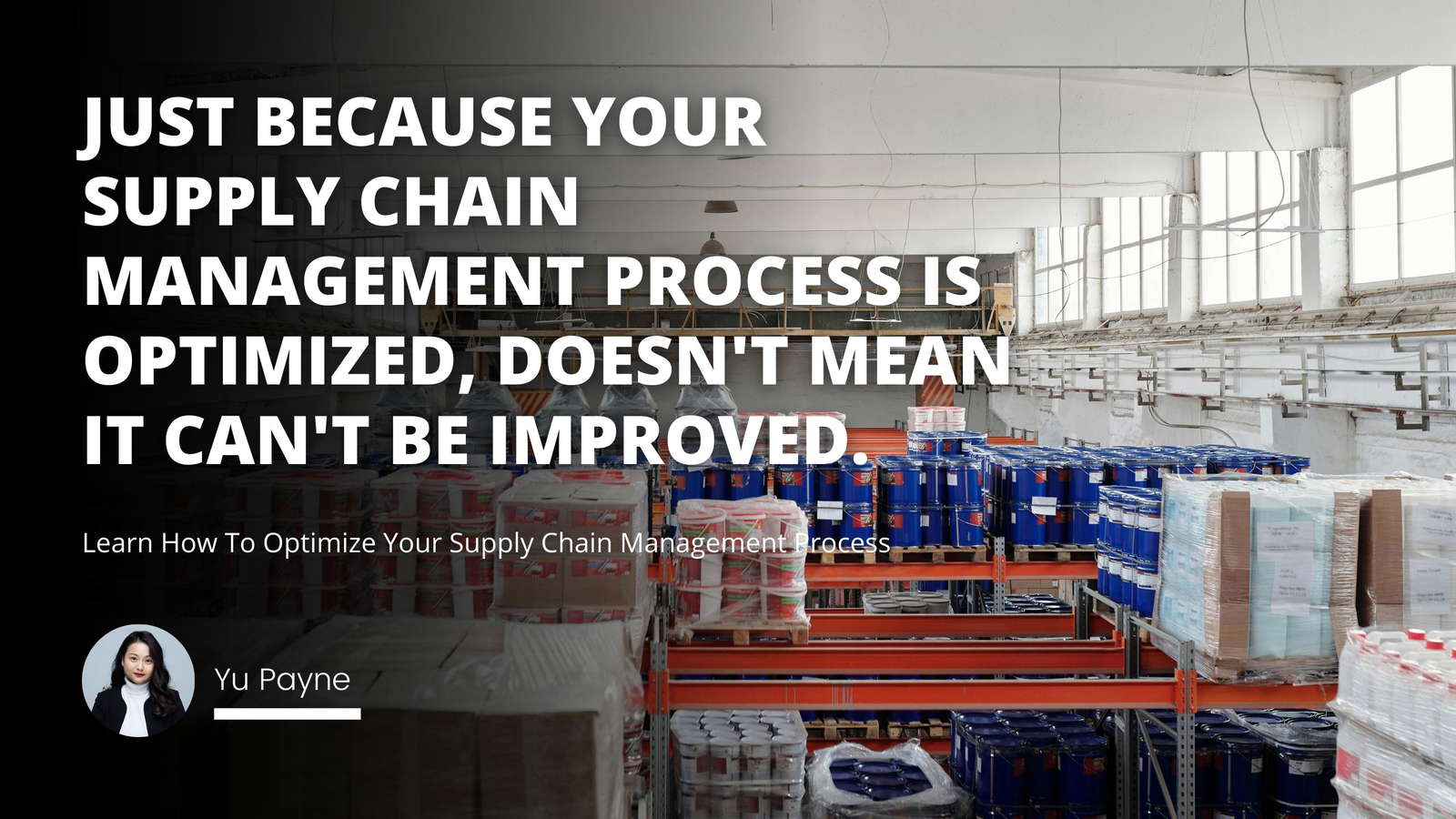
I still remember the day when our company lost out on a major client because we couldn't deliver the products on time. It wasn't because we didn't have the capacity, but because our sales and operations teams were not on the same page. This incident opened my eyes to the critical importance of harmony between sales and operations.
Bridging the Gap Between Sales and Operations
In every business, sales and operations are like the two sides of a coin. While sales focus on generating customer demand, operations are responsible for fulfilling that demand efficiently. However, these departments often have conflicting priorities, leading to tensions that can impact the entire organization.
Introduction
Sales vs. Operations
Supply Chain Conflict
Managing Conflict
Conclusion
The Role of Sales
Sales teams are the driving force behind revenue generation. They are out there in the field, understanding customer needs, and closing deals. Their primary goal is to maximize sales, sometimes even pushing for higher inventory levels to ensure they never miss a sale due to stockouts.
The Role of Operations
On the flip side, operations focus on efficiency and cost management. They are tasked with producing, transporting, and storing products while keeping expenses low. Operations aim to minimize inventory levels to reduce holding costs and avoid overproduction.
Where Conflict Arises
The conflict between sales and operations often stems from their differing objectives:
1- Inventory Levels:
Sales want high inventory to meet any level of customer demand.
Operations prefer low inventory to reduce costs.
2- Demand Forecasting:
Sales may overestimate demand to ensure product availability.
Operations might underestimate demand to avoid excess inventory.
3- Resource Allocation:
Sales push for more resources to boost sales activities.
Operations seek to streamline resources for efficiency.
I once worked with a sales manager who insisted on doubling our inventory for a new product launch. Operations were hesitant due to the high carrying costs. The lack of alignment led to excess stock that took months to clear, impacting our profitability.
Strategies for Managing Conflict
Managing the tension between sales and operations is crucial for business success. Here are some effective strategies I've found helpful:
1. Enhance Communication
Regular meetings and open communication channels help both teams understand each other's perspectives. Cross-departmental meetings can:
Align goals and expectations.
Share valuable insights from both sides.
Build mutual respect and understanding.
2. Collaborative Forecasting
Developing joint demand forecasts ensures that both sales and operations contribute their insights. This collaboration can lead to more accurate forecasts by:
Combining market trends observed by sales with historical data analyzed by operations.
Regularly updating forecasts based on real-time data.
Adjusting production plans proactively.
3. Integrated Supply Chain Management
Carload Freight Supply Chain Management Benefits Challenges Strategies
How To Measure Supply Chain Processes Using Quantitative And Qualitative Metrics
Implementing an integrated supply chain management system allows for:
Real-time data sharing between departments.
Visibility into inventory levels, production schedules, and sales orders.
Better decision-making based on comprehensive information.
4. Aligning Incentives
Ensure that both teams are working towards shared goals by:
Setting common performance metrics tied to overall business success.
Offering incentives that promote collaboration rather than competition.
Recognizing team achievements collectively.
Tips to Optimize Supply Chain Management Process
Drawing from my experience, here are some practical tips to optimize supply chain management processes:
The key to managing supply chain conflict is finding the balance between sales and operations.
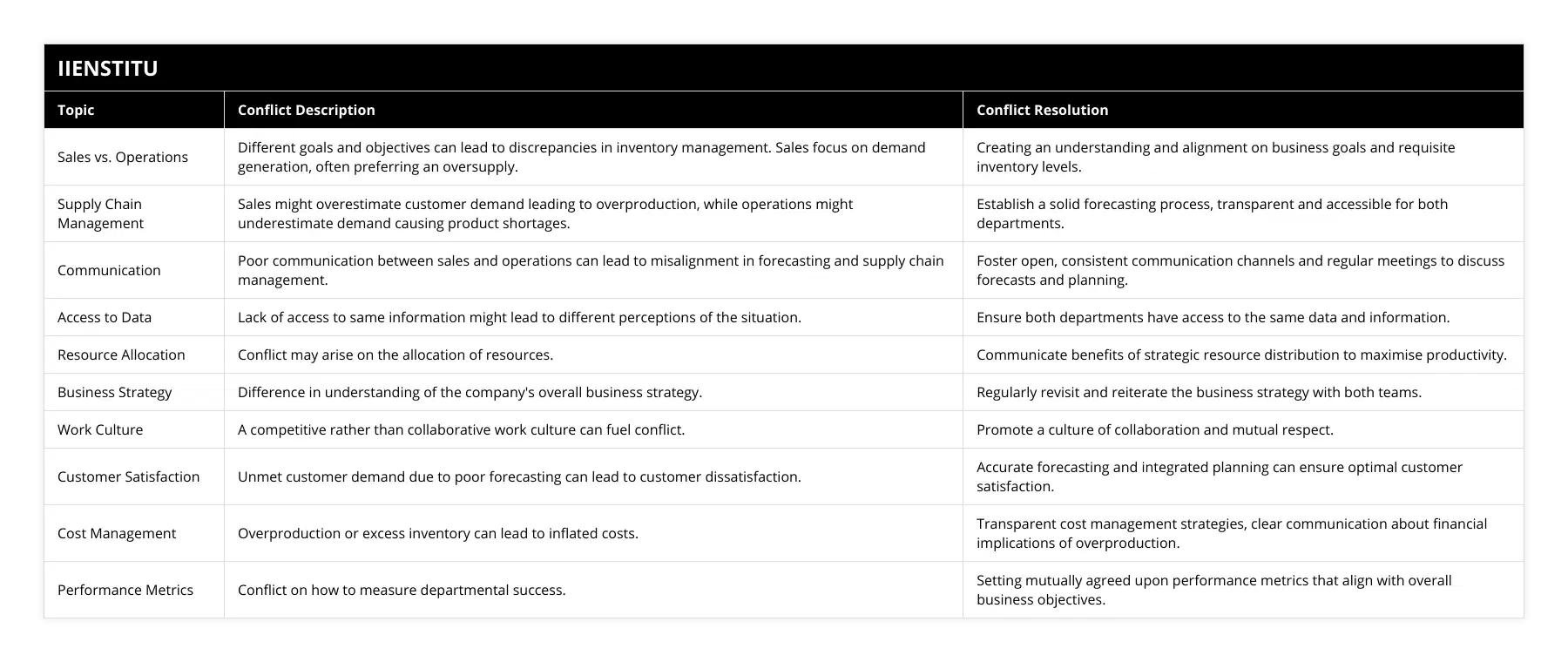
1- Invest in Technology: Utilize supply chain management software that offers analytics and forecasting tools.
2- Adopt Lean Principles: Implement lean inventory practices to reduce waste and improve efficiency.
3- Foster Supplier Relationships: Build strong relationships with suppliers for better negotiation and collaboration.
4- Continuous Improvement: Regularly review and refine processes to adapt to market changes.
5- Train and Develop Staff: Equip your teams with the skills and knowledge to use new technologies and methodologies effectively.
By incorporating these steps, companies can create a more agile and responsive supply chain that meets customer demands without unnecessary costs.
Personal Experience: A Success Story
In my previous role, we faced significant challenges due to the disconnect between sales and operations. To address this, we initiated a project that involved:
Setting up a joint task force with members from both departments.
Conducting workshops to understand each other's processes.
Developing a shared dashboard that displayed key metrics.
The result? We saw:
A 15% reduction in inventory costs.
Improved customer satisfaction scores due to better product availability.
A more cohesive work environment where teams supported each other.
The Importance of Balance
Ultimately, the key to success lies in finding the right balance between meeting customer demands and managing operational efficiency. Neither sales nor operations can function effectively in isolation. They must work together to:
Provide value to customers.
Drive profitability.
Sustain long-term growth.
As highlighted in "Operations Management: Processes and Supply Chains" by Krajewski, Malhotra, and Ritzman, "A well-coordinated effort between sales and operations is essential for creating a competitive advantage in the marketplace."
Conclusion
Navigating the complexities of sales and operations requires clear communication, collaboration, and a shared vision. By implementing the strategies discussed, organizations can reduce conflicts and enhance their overall performance.
Remember, it's not about sales versus operations; it's about sales and operations working hand in hand to achieve common goals. By fostering a culture of collaboration, companies can ensure that both departments are aligned and moving forward together.
References
Krajewski, L. J., Malhotra, M. K., & Ritzman, L. P. (2019). Operations Management: Processes and Supply Chains. Pearson.
Simchi-Levi, D., Kaminsky, P., & Simchi-Levi, E. (2008). Designing and Managing the Supply Chain. McGraw-Hill.
Chopra, S., & Meindl, P. (2016). Supply Chain Management: Strategy, Planning, and Operation. Pearson.
Goldratt, E. M., & Cox, J. (2004). The Goal: A Process of Ongoing Improvement. North River Press.
Stevenson, W. J. (2021). Operations Management. McGraw-Hill Education.
Feel free to share your experiences or tips on managing the balance between sales and operations. Let's learn from each other and grow together!
Frequently Asked Questions
What strategies can be used to balance sales and operations in a supply chain?
Successfully managing a supply chain requires ensuring that sales and operations are balanced. To achieve this, several strategies can be employed.
One approach is to improve the coordination between sales and operations. This can be done by improving communication between departments and creating a shared understanding of objectives and strategies. This should involve increasing the visibility of the supply chain, allowing for more effective collaboration and decision-making. Additionally, developing a standard set of performance metrics can help ensure that both sales and operations are working towards the same goals.
Another strategy for balancing sales and operations is to adopt a demand-driven approach to the supply chain. This involves understanding customer demand and creating an agile supply chain that can quickly and effectively respond to changes in demand. This should include establishing a robust forecasting system and developing flexible production and distribution plans. Additionally, it may be beneficial to use inventory optimization techniques to ensure that the right level of stock is maintained to meet customer demand.
It is also important to ensure that the supply chain is efficient and cost-effective. This involves identifying inefficient areas of the chain and looking for ways to streamline them. This can include improving resource utilization and optimizing production and distribution processes. Additionally, it may be beneficial to use technology to automate certain processes.
Finally, it is important to ensure that sales and operations align with each other. This involves understanding the objectives of each department and developing strategies that support them. Additionally, it is important to ensure that the supply chain is agile and able to respond quickly to changes in demand. This may involve implementing new technologies, such as predictive analytics, to help better anticipate customer needs.
A successful supply chain requires ensuring that sales and operations are balanced. To achieve this, a number of strategies can be employed, such as improving coordination between sales and operations, adopting a demand-driven approach, ensuring efficiency and cost-effectiveness, and ensuring that sales and operations are in alignment with each other. Following these strategies makes it possible to balance sales and operations in a supply chain.

How can supply chain conflict be managed effectively?
Supply chain conflict is an unavoidable part of business operations and can arise for a variety of reasons, including cost, quality, delivery times, communication, and more. It is, therefore, essential that organizations have a strategy in place to effectively manage such conflict.
The first step in managing supply chain conflict is identifying and addressing its root causes. It is important to understand why the conflict has arisen and to address the underlying issues. This will help to prevent similar issues from occurring in the future. Additionally, it is important to ensure that all parties involved in the supply chain are open to providing feedback and engaging in dialogue.
Once the root cause of the conflict has been identified, it is essential to create a resolution plan. This may involve stakeholders agreeing on a solution or setting a timeline for resolution. Additionally, it is essential to ensure that the resolution is communicated clearly to all parties involved.
It is also essential to ensure that the resolution does not disrupt the supply chain. This will involve ensuring that the resolution does not impact the supply of goods or services or the quality of the products. Additionally, it is important to ensure that the resolution is fair and equitable to all parties involved.
Finally, ensuring that effective communication is maintained throughout the conflict resolution process is essential. This will involve ensuring that all parties are kept informed of the progress of the resolution and that any new information is communicated clearly and promptly.
In conclusion, organizations must have a strategy in place to effectively manage supply chain conflict. This will involve identifying and addressing the root causes of the conflict, creating a resolution plan, ensuring that the resolution does not disrupt the supply chain, and maintaining effective communication throughout the process. By taking these steps, organizations can manage supply chain conflict effectively.
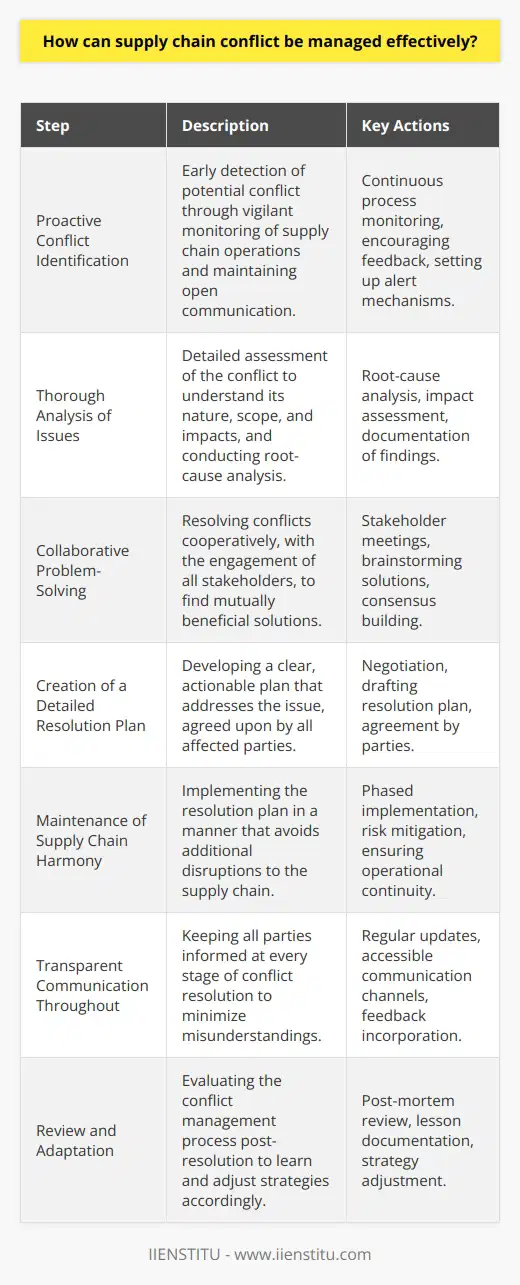
What are the benefits of balancing sales and operations in a supply chain?
The integration of sales and operations in a supply chain is of vital importance to optimize the performance of the entire system. Balancing sales and operations helps companies manage their resources effectively, reduce costs, and increase customer satisfaction.
The most apparent benefit of balancing sales and operations in a supply chain is the improved efficiency of the entire system. By streamlining processes, it is possible to reduce costs, increase productivity, and improve the overall quality of products and services. This can lead to improved customer satisfaction and increased profits. Additionally, balancing sales and operations can help organizations better understand customer needs. This understanding can then be used to create more efficient processes, which can further reduce costs and increase profits.
Another benefit of balancing sales and operations in a supply chain is the system's increased visibility. This visibility can help companies to identify inefficiencies and areas of improvement, as well as to track the performance of their products and services. This improved visibility can also help companies better manage risks, as they can detect potential problems and take corrective action before they become significant issues.
Finally, balancing sales and operations can help companies to increase their agility and responsiveness. By taking a proactive approach to managing the supply chain, companies can better identify and react to changes in customer demand and market conditions. This increased agility and responsiveness can help companies to remain competitive in the market, as well as serve their customers better.
In conclusion, balancing sales and operations in a supply chain can offer many benefits, including improved efficiency, visibility, and agility. Companies can maximize their profits and better serve their customers by taking a holistic approach to supply chain management.
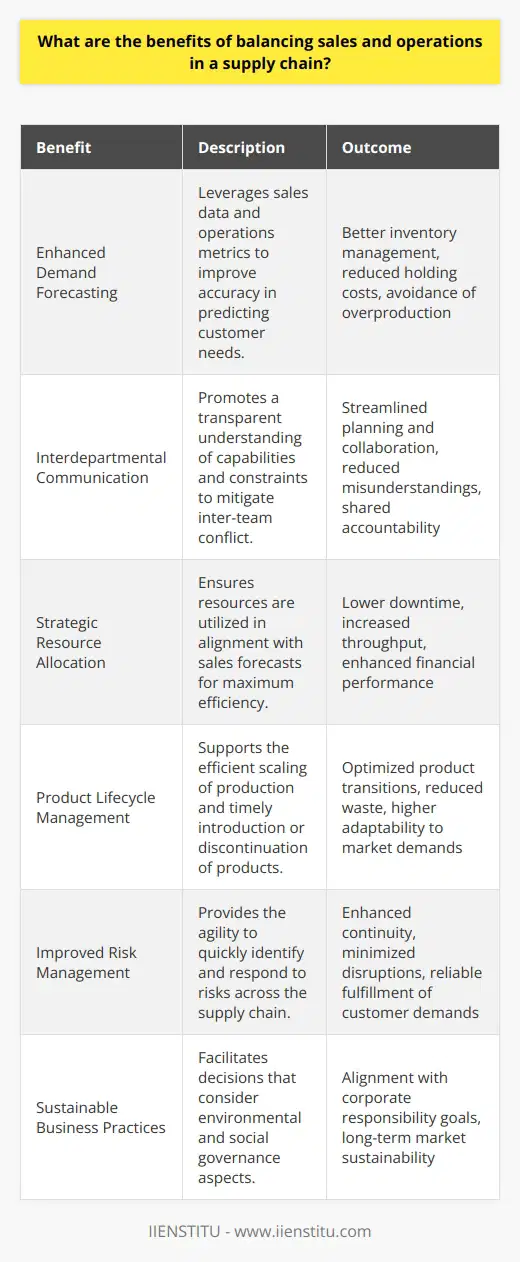
What is the role of operations and supply chain strategy in achieving business objectives?
The Significance of Operations and Supply Chain Strategy
To achieve business objectives, companies must implement effective operations and supply chain strategies. Operations strategy primarily involves the management of resources, functions, and processes within a company, enabling the efficient production and delivery of products and services. Supply chain strategy, on the other hand, pertains to the coordination and integration of suppliers, manufacturers, and distributors to ensure smooth product flow and meet customer demands.
The Alignment and Integration of Business Objectives
A well-crafted operations and supply chain strategy contributes to the accomplishment of several business objectives. First, it enhances customer satisfaction by producing high-quality, innovative products and ensuring their timely delivery. By streamlining operations and supply chain activities, businesses can meet or exceed customer expectations, ultimately improving their market share and profitability.
Cost Reduction and Efficiency Enhancement
Second, adopting an effective operations and supply chain strategy allows a business to reduce costs and improve productivity. This strategy often involves optimizing resource utilization, minimizing waste, and implementing lean manufacturing principles. The result is a more efficient production process and a reduction in operational expenses, contributing to a higher profit margin for the company.
The Impact on Competitiveness and Innovation
Third, businesses with robust operations and supply chain strategies are more adaptable to changes in market conditions and better equipped to innovate. A strong strategic foundation enables companies to react quickly to external factors, such as new competitors, shifts in customer preferences, or advances in technology. By being agile and embracing change, businesses can develop a competitive advantage and stay ahead in their respective industries.
Risk Management and Corporate Sustainability
Lastly, a well-designed operations and supply chain strategy helps a business mitigate risks and ensure long-term sustainability. By identifying potential vulnerabilities and threats across the supply chain, companies can implement contingency plans, maintain a reliable supplier base, and diversify their operations. In this manner, businesses can weather unforeseen disruptions and maintain stability in the face of economic, political, or environmental challenges.
In conclusion, operations and supply chain strategy plays a crucial role in achieving business objectives. Through enhanced efficiency, cost reduction, increased competitiveness, and risk management, companies can drive growth, maintain profitability, and ensure long-term success.
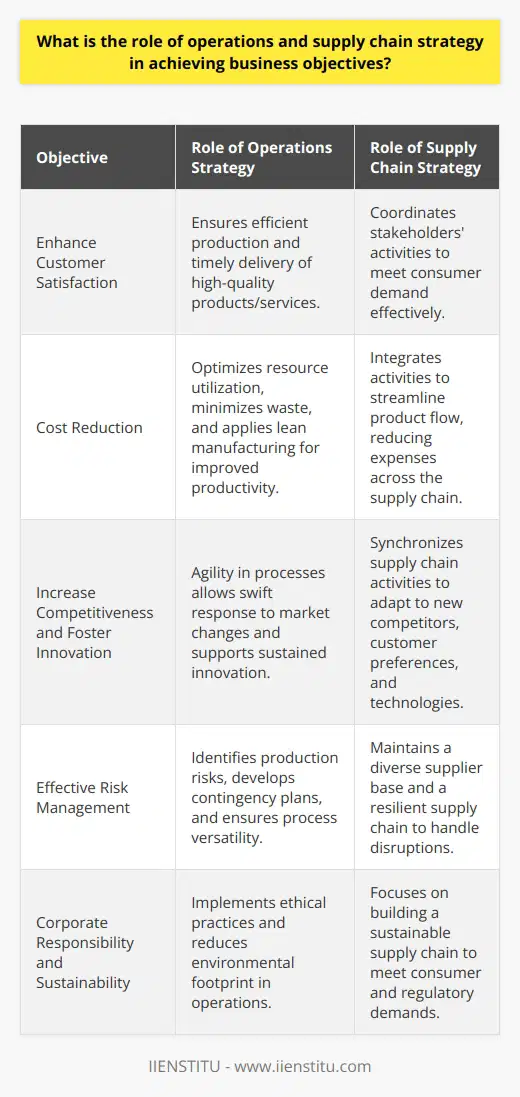
How do we address the major areas of conflict in supply chain management to ensure smooth operations?
Addressing Supplier-Client Conflicts
A primary area of conflict within supply chain management lies in potential disputes between suppliers and clients. To ensure smooth operations, it is essential to establish clear communication channels, promoting understanding of each party's requirements and maintaining transparency in business transactions. Implementing service level agreements (SLAs) and key performance indicators (KPIs) will serve as valuable tools to set mutual expectations, monitor performance, and identify areas for improvement.
Balancing Cost and Quality
Another aspect of concern in supply chain management is striking the right balance between cost efficiency and product quality. Prioritizing either may result in dissatisfaction for clients, compromised returns for suppliers or a suboptimal supply chain configuration. To effectively address this issue, companies ought to adopt a value-driven supply chain approach, focusing on delivering optimal value to customers through reliable processes, efficient cost structures, and continuous improvement programs.
Employing Ethical Practices
Ethics in supply chain operations is of the utmost importance and any breach can lead to conflicts between stakeholders. By developing and enforcing a comprehensive code of conduct, companies can ensure ethical behavior throughout the entire supply chain. This includes aspects such as responsible sourcing, fair labor practices, and environmental stewardship. Regular audits, third-party certifications, and evaluations can provide valuable insights into potential discrepancies, allowing companies to take swift corrective action and maintain harmonious relationships.
Embracing Conflict Resolution
In order to proactively address supply chain conflicts, companies must be equipped with robust conflict resolution mechanisms. This includes establishing defined escalation procedures and channels for communication between parties involved in disputes. Setting up a dedicated cross-functional team to assess conflict situations and recommend remedial measures can be instrumental in mitigating risks and maintaining smooth operations. Furthermore, fostering a culture of collaboration and open dialogue can contribute to a proactive identification and resolution of potential issues.
In conclusion, effectively addressing conflicts in supply chain management requires a multifaceted approach that encompasses clear communication, value-driven operations, ethical practices, and robust conflict resolution mechanisms. By prioritizing and implementing these strategies, companies can ensure smooth operations and maintain productive relationships with stakeholders across the supply chain.
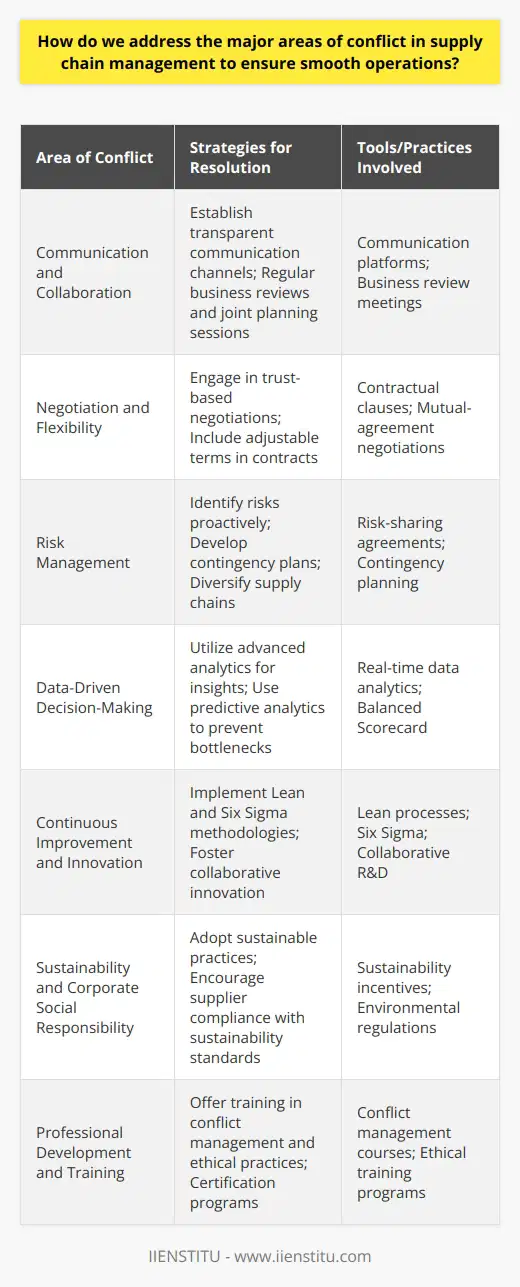
Can you explain the concept of balancing demand and supply, and its significance in supply chain management?
Balancing Demand and Supply
The concept of balancing demand and supply revolves around ensuring that the quantity of goods produced and distributed meets the needs and preferences of consumers while effectively utilizing resources. This balance is achieved when the quantity demanded is equal to the quantity supplied, leading to market equilibrium. In supply chain management, balancing demand and supply is essential because it allows for seamless operations, timely delivery of products, and overall optimization of resources.
Importance in Supply Chain Management
First, balancing demand and supply enhances inventory control. Adequate inventory management is critical in ensuring that goods are available when needed, thereby reducing stockouts and minimizing the need for backorders. By accurately gauging and satisfying consumer demand, businesses avoid accumulating excess stock that may lead to obsolescence and increased carrying costs.
Second, efficient allocation of resources is ensured. Balancing demand and supply allows companies to identify and prioritize high-demand products, allocate resources accordingly, and fulfill customer orders promptly. This prevents overproduction of unwanted items and, in turn, contributes to reduced waste and operational costs.
Third, customer satisfaction is enhanced. Supply chain management thrives on meeting customer expectations concerning product availability and delivery time frames. Balancing demand and supply results in optimized performance and leads to satisfied customers who are more likely to become brand loyal and provide repeat business.
Finally, risk mitigation is achieved. An effective demand and supply balance help companies assess and navigate risks, including fluctuations in demand, disruptions in the supply chain, or changes in regulations. By continually monitoring and adjusting for demand and supply changes, firms increase their resilience and adaptability to challenges.
In conclusion, balancing demand and supply is an integral aspect of supply chain management, playing a vital role in prioritizing resources, enhancing inventory control, and increasing customer satisfaction while mitigating risks. Achieving this balance ultimately leads to more efficient operations, cost savings, and a competitive advantage in the market.
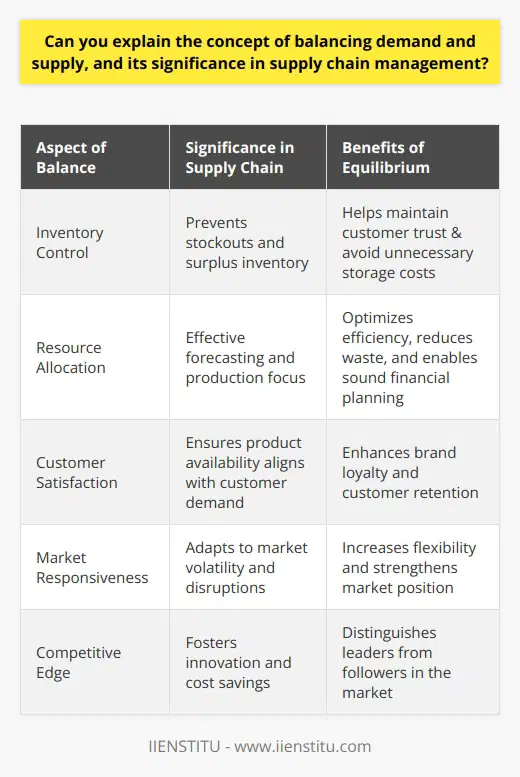
What are the key components of a successful sales and operations planning process?
Sales and Operations Planning Process
Overview:
A successful sales and operations planning (S&OP) process is essential for organizations to ensure that they meet their customer needs while optimizing their use of resources. The key components of an effective S&OP process include: demand forecasting, supply chain management, collaborative decision-making, performance monitoring, and continuous improvement.
Demand Forecasting:
To achieve a successful S&OP process, accurate demand forecasting is crucial. This involves analyzing historical sales data, market trends, and customer preferences to predict future demand. By understanding the potential demand, organizations can efficiently allocate their resources and align their operational capacity with their customers' needs.
Supply Chain Management:
A well-integrated supply chain is a vital component of the S&OP process. This requires coordination between different functions, such as purchasing, logistics, and inventory management. Effective supply chain management ensures that raw materials, labor, and other resources are in place to meet the demand forecast, minimizing the risk of stockouts and delays.
Collaborative Decision-Making:
The S&OP process requires cross-functional collaboration to ensure that all relevant perspectives are considered. This includes engaging with various stakeholders from marketing, finance, and operations to discuss forecasts, assess resource requirements, and determine the most feasible plan of action. Collaborative decision-making helps organizations create a more accurate sales and operations plan and fosters alignment among teams.
Performance Monitoring:
Tracking key performance indicators (KPIs) is essential for evaluating the effectiveness of the S&OP process. KPIs can include metrics related to customer service, operational efficiency, and financial performance. Monitoring these indicators allows organizations to identify any deviations from the plan, make necessary adjustments, and ensure that they are moving towards their targeted objectives.
Continuous Improvement:
To maintain a successful S&OP process, organizations must embrace a culture of continuous improvement. This entails regularly revisiting the plan, identifying areas of weakness or opportunity, and updating the S&OP process based on new insights or shifting priorities. By refining their S&OP process over time, organizations can stay agile and better adapt to the dynamic business environment.
Conclusion:
In summary, a successful sales and operations planning process relies on accurate demand forecasting, effective supply chain management, collaboration, performance monitoring, and a commitment to continuous improvement. By focusing on these key components, organizations can align their resources with their customer needs, optimize their operations, and ultimately achieve their strategic objectives.
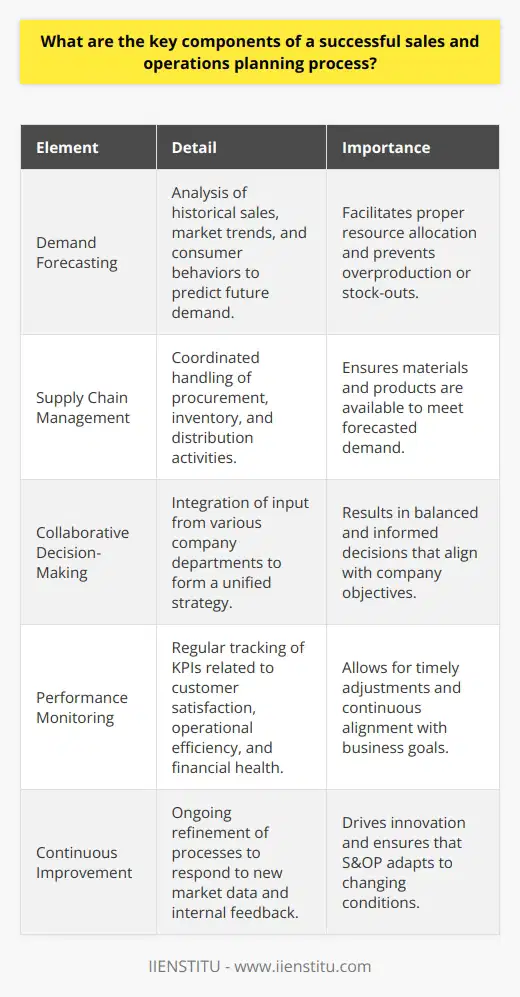
How do demand forecasting and inventory management contribute to effective supply chain management?
Demand Forecasting: A Key Factor in Supply Chain Management
Demand forecasting, which refers to the estimation of consumer demand for a product or service, plays a crucial role in effective supply chain management. Accurate demand forecasting enables businesses to better understand their customers' needs and preferences, allowing them to efficiently allocate resources to meet those needs. As a result, businesses can optimize their production levels, reduce waste and minimize the risk of overstock or stockouts.
Inventory Management: Ensuring Optimal Stock Levels
In tandem with demand forecasting, inventory management contributes to successful supply chain management by maintaining appropriate stock levels and ensuring product availability. By implementing effective inventory management systems, businesses can track and monitor their goods at any point in the supply chain, leading to enhanced visibility and control. Moreover, efficient inventory management helps businesses minimize costs associated with excess inventory and storage, improving their overall profitability.
Combining Demand Forecasting and Inventory Management
Together, demand forecasting and inventory management create a synergistic framework for supply chain excellence. By integrating demand forecasting data into inventory management processes, companies can align their stock levels with anticipated customer demand, reducing excess inventory and increasing customer satisfaction. This integration enables businesses to be more responsive to changing market conditions, positively impacting their ability to compete in the global market.
In conclusion, demand forecasting and inventory management are essential components of effective supply chain management, as they provide the foundation for matching supply with demand. By incorporating these practices into their operations, businesses can improve their efficiency, reduce costs, and enhance their overall competitiveness in the market.
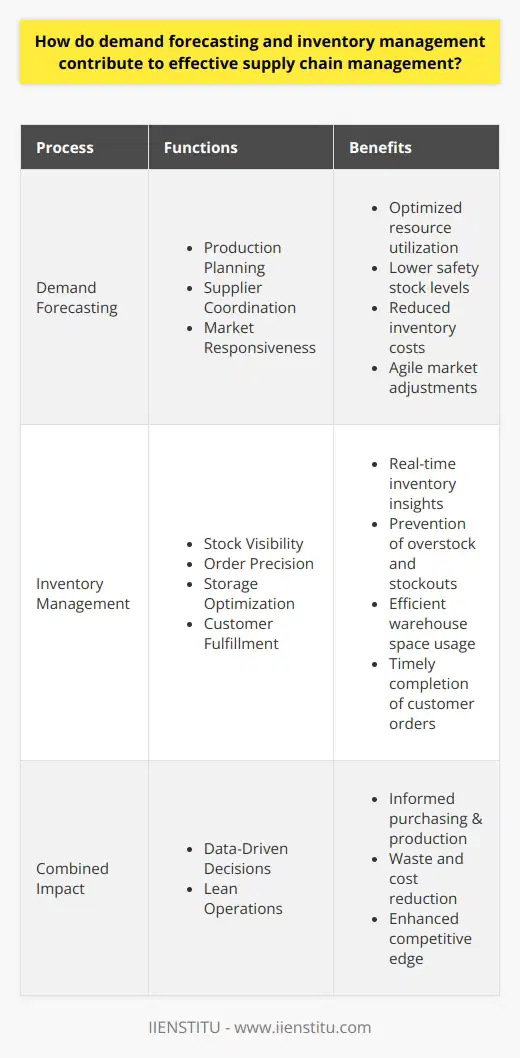
What is the role of technology in addressing supply chain conflicts and enhancing the balance between supply and demand?
Role of Technology in Mitigating Conflicts
Technology plays a crucial role in addressing supply chain conflicts and enhancing the balance between supply and demand. Various technological innovations are employed with the aim of resolving issues in the supply chain, thus facilitating seamless operations.
Digital Platforms for Collaboration
To promote transparency in supply chains, digital platforms are implemented for better collaboration between suppliers and customers. These platforms enable real-time data sharing, aiding in the prediction, detection, and resolution of potential conflicts, resulting in a more efficient supply chain.
IoT and Big Data Analytics
The Internet of Things (IoT) and big data analytics are significant drivers of supply chain optimization. IoT devices collect critical information along the supply chain, while advanced analytics enable data-driven decisions, reducing discrepancies, and ensuring smoother operations.
Artificial Intelligence in Planning
Artificial intelligence (AI) is instrumental in providing better demand forecasting and resource planning. AI algorithms predict customer demand patterns and guide suppliers in making informed decisions, streamlining inventory management, and maintaining equilibrium between supply and demand.
Blockchain for Traceability
Another promising technology in tackling supply chain conflicts is blockchain. Its decentralized nature offers increased security, traceability, and accountability of transactions, eliminating information silos and allowing stakeholders to access reliable data while resolving disputes.
Automation and Robotics
Implementing automation and robotics in supply chain management reduces human error and increases the efficiency and speed of processes. By automating repetitive tasks, manufacturers and suppliers can save time, minimize errors, and focus on addressing potential conflicts in a timely manner.
In conclusion, technology has the potential to address and mitigate supply chain conflicts effectively. Adopting digital platforms, IoT, big data analytics, AI, blockchain, and automation technologies can help balance supply and demand. It ensures seamless operations, transparent collaborations, and better decision-making, ultimately achieving supply chain optimization.
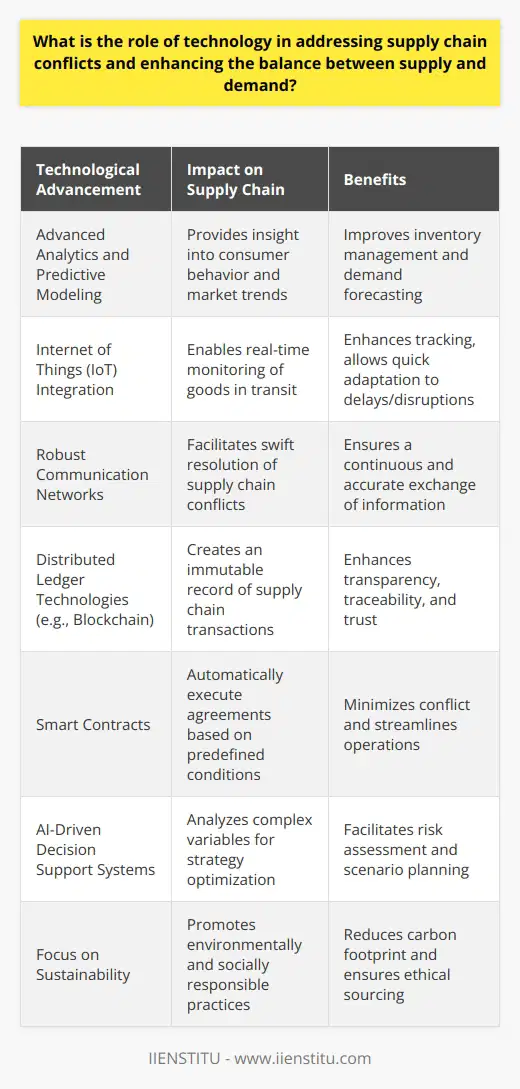
What are the potential consequences of not effectively managing supply chain conflicts?
Potential Consequences of Mismanagement
Failure to effectively manage supply chain conflicts can lead to several adverse consequences. The most immediate consequence is often operational disruptions. These can result in service delays, declining product quality, or even a complete halt in operations.
Implications for Business Entities
Such disruptions can then affect the financial viability of the business. It may lead to loss of sales, increased operational costs, and potentially severe financial losses. In worst-case scenarios, these conflicts can cause bankruptcy or business closure.
Effects on Competitive Advantage
Conflicts can also affect a company's competitive advantage. A well-functioning supply chain enables a business to deliver products quickly, maintain high quality, and keep costs low. If conflicts disrupt the supply chain, companies may struggle to meet customer expectations in these key areas.
Customer Satisfaction
In the long run, inability to manage conflicts can severely affect customer satisfaction. Customers may experience delayed deliveries, defective products, and increased prices. Consequently, this may lead to reduced customer loyalty and a decline in repeat business.
Reputation Damage
Lastly, these conflicts can harm the company’s public image and reputation. News of supply chain issues can spread quickly, especially in today's digital age. This can deter potential customers and diminish stakeholder trust.
In sum, not managing supply chain conflicts effectively can bring serious operational, financial, competitive, customer-related, and reputational damages. Therefore, businesses should emphasize on effective conflict management strategies in their supply chain operations for long-term success.

How does incorporating sustainability measures impact the overall balance and management of supply chains?
Incorporation of Sustainability Measures
Employing sustainability measures significantly affects the equilibrium and management of supply chains. First, incorporating such practices can lead to a reduction in costs. Sustainable initiatives often involve minimizing waste, improving energy efficiency, and recycling materials – all of which can substantially lower operational expenses.
Impact on Operational Efficiency
Secondly, prioritizing sustainability can enhance operational efficiency in the supply chain. Businesses that commit to sustainable practices often inspire employees, suppliers, and partners to do the same. This mutual understanding can lead to streamlined operations, improved collaboration, and increased efficiency.
Relevance of Risk Management
Furthermore, sustainability is often associated with effective risk management. Increasing the supply chain's resilience to disruptions by reducing dependence on non-renewable resources helps mitigate risks, such as volatile commodity prices and regulatory penalties for non-compliance.
Importance in Stakeholder Relationships
Moreover, sustainability measures can improve relationships with stakeholders. Stakeholders are increasingly demanding businesses to demonstrate corporate social responsibility, including sustainability. As a result, companies that incorporate sustainability into their supply chains may attract more customers, secure higher customer loyalty, and promote brand differentiation.
Promoting Innovation
Finally, sustainability can stimulate innovation within the supply chain. As competitive landscapes shift towards low-carbon and resource-efficient value propositions, companies that pursue sustainability are well-positioned to lead the market with new products, services, and business models.
In conclusion, incorporating sustainability measures can impact supply chains in numerous ways. These include cost reductions, improved operation efficiency, effective risk management, improved stakeholder relationships, and heightened innovation. Therefore, businesses would greatly benefit by adopting sustainability practices into their supply chain management strategies.
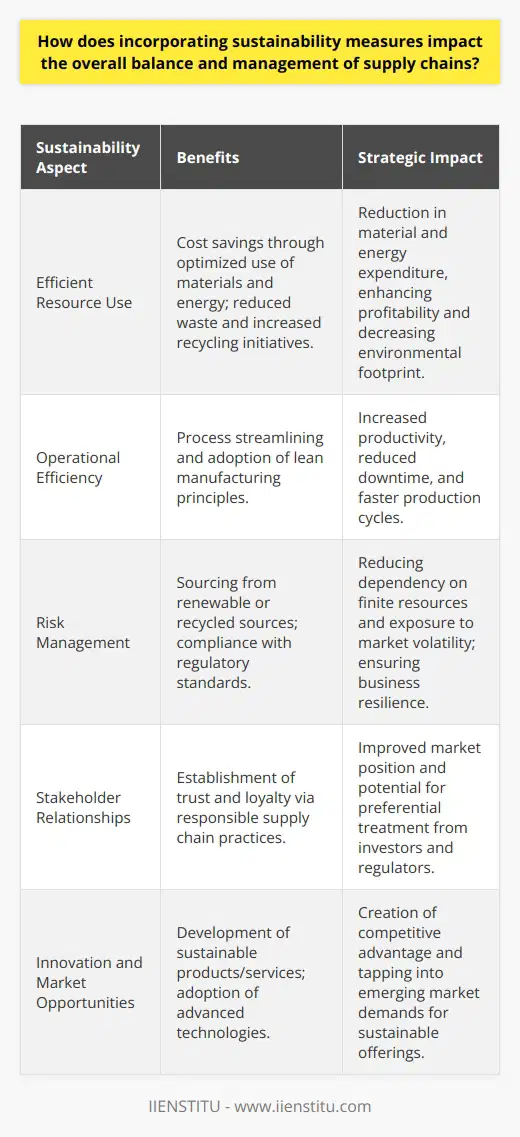
In what ways can an organization's culture and communication practices contribute to resolving supply chain conflicts and achieving a balance between supply and demand?
Promoting Collaborative Culture
A strong organizational culture can significantly bolster supply chain conflict resolution. Organizations that foster a culture of collaboration and open communication are more likely to address conflicts effectively. This is because they facilitate teamwork, negotiations, and mutual problem-solving, fostering an environment where members find and implement solutions collectively.
Enhancing Communication Practices
Effective communication practices form the bedrock of successful conflict resolution in supply chains. Clear, concise, and timely communication helps prevent misunderstandings that may escalate into conflicts. Regular updates about supply-demand dynamics, order statuses and fulfillment risks can avert sudden shocks and provide opportunities to adjust plans accordingly.
Building Transparency and Trust
Trust and transparency, prevalent in healthy organization cultures, aid in balancing supply and demand. Close collaboration, fostered by trust, allows for real-time sharing of demand and supply data. This, in turn, helps organizations anticipate demand shifts and adjust production schedules timely, thus balancing supply and demand.
Leveraging Conflict Resolution Strategies
An organization’s culture can also contribute to conflict resolution by propagating conflict management strategies. Having clear protocols in place for addressing disputes, along with a positive environment that views conflict as an opportunity for improvement, can pave the way for smoother conflict resolution.
In summary, an organization's culture and communication practices play a pivotal role in resolving supply chain conflicts and achieving a balance between supply and demand. Effective communication practices foster collaboration, promote transparency and anticipate demand shifts. Meanwhile, embracing conflict resolution in the organization culture could offer a blueprint for constructive and proactive conflict management.
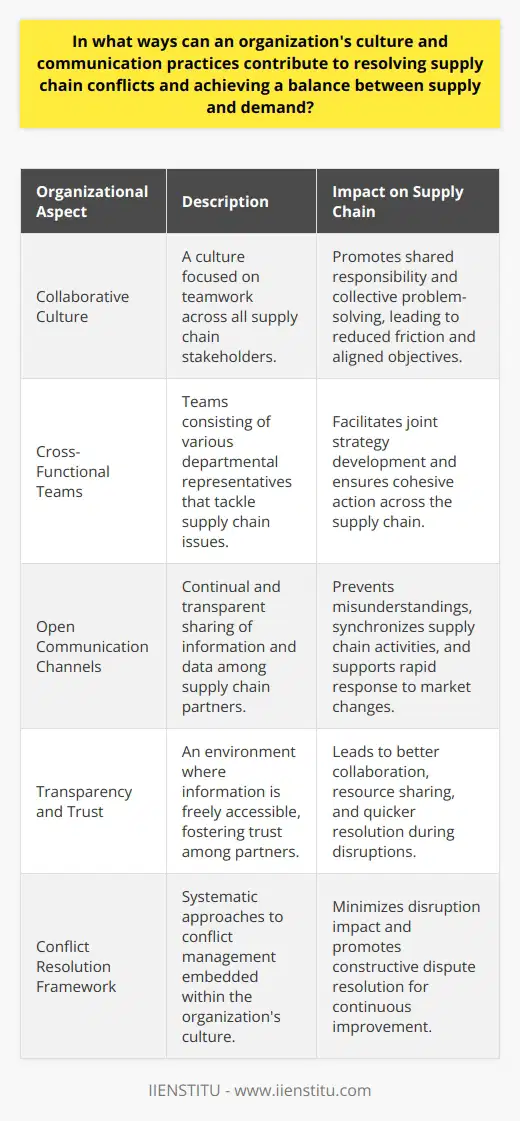
How do you resolve conflict in supply chain?
Methodology for Conflict Resolution
Conflict resolution in a supply chain entails a systematic approach. The first step involves identifying the source of the conflict. This identification seeks to understand the underlying issues and contributors to the dispute.
Application of Communication Tools
Effective communication plays a crucial role in the next phase. This action involves discussing the identified conflict with all stakeholders. They may include suppliers, manufacturers, distributors, and retailers.
Teamwork and Collaboration
The third step involves fostering teamwork and collaboration. Stakeholders must willingly participate in finding a solution. They have to be ready to make compromises for the greater good of the supply chain.
Data-Driven Decision Making
Next, data-driven decision making helps identify the most viable solution. Analyzing past trends, forecasts, and real-time data often leads to informed decisions. This increases the likelihood of resolving the conflict satisfactorily.
Execution of Agreed Resolutions
Once the parties reach a solution, implementation follows. All stakeholders need to adhere to the agreed-upon resolutions. This stage fosters harmony and boosts efficiency in the supply chain.
Evaluation and Reflection
Lastly, after executing the conflict resolution plan, it's necessary to evaluate its effectiveness. Reflect on the process and outcome. This reflection will enable the supply chain management to learn and prepare for any future conflicts.
Effective conflict resolution in the supply chain primarily requires a systematic approach, including identification of the conflict source, open communication, teamwork, data-driven decision making, execution of resolutions, and evaluation. Applying this methodology can lead to smoothed operations and improved supply chain relationships.
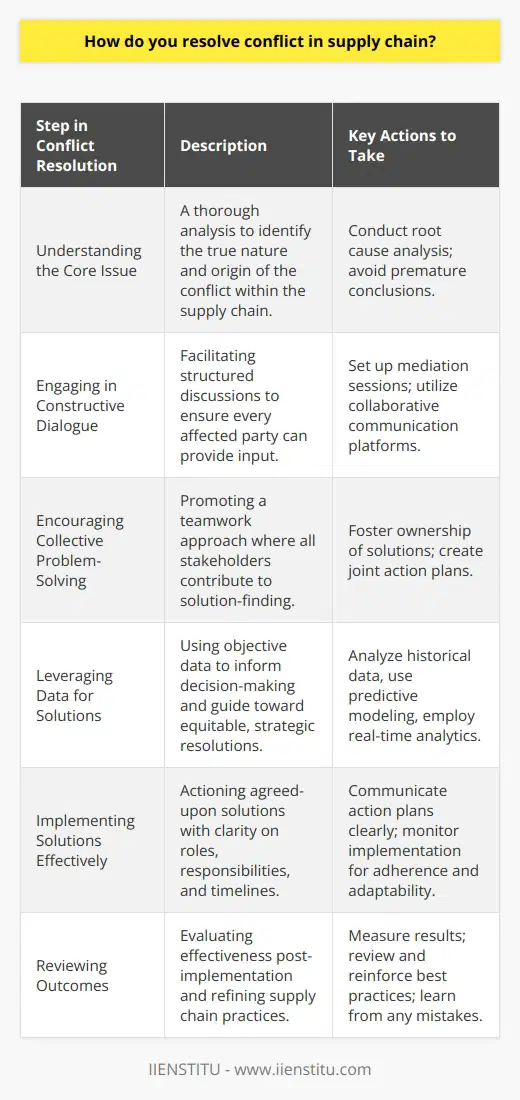
How important is effectively managing the supply chain and balancing demand and supply?
Significance of Effective Supply Chain Management
Managing the supply chain effectively is vital. It boosts productivity, improves customer satisfaction, and increases revenue. With a well-operated supply chain, businesses can ensure the efficient delivery of products and services.
Balancing Demand and Supply
Balance between demand and supply is another critical aspect of supply chain management. It ensures products are available when customers need them, thereby enhancing customer loyalty and reducing the risk of losses due to unsold inventory.
Impacts of Unbalanced Demand and Supply
Unbalanced demand and supply, on the other hand, can lead to stockout or overstock situations. The former could damage the firm’s reputation and cost the company sales. The latter results in storage costs and possible wastage of resources.
Tools for Managing Supply Chain
Various forecasting and inventory management tools can help businesses anticipate customer behavior and manage their supply chain more efficiently. These tools can analyze sales and ordering patterns, allowing businesses to better predict demand and adjust their supply accordingly.
Link between Supply Chain Management and Business Performance
The efficient management of the supply chain and the balance between demand and supply directly contributes to overall business performance. Businesses that fail to manage their supply chain effectively risk losing customers, increasing costs, and reducing profits.
In conclusion, effective supply chain management and balancing of demand and supply are not only beneficial but also critical to the successful operation and sustainability of a business in the long run. Proper management of these aspects results in various benefits, including increased customer satisfaction, enhanced operational efficiency, and improved profitability.
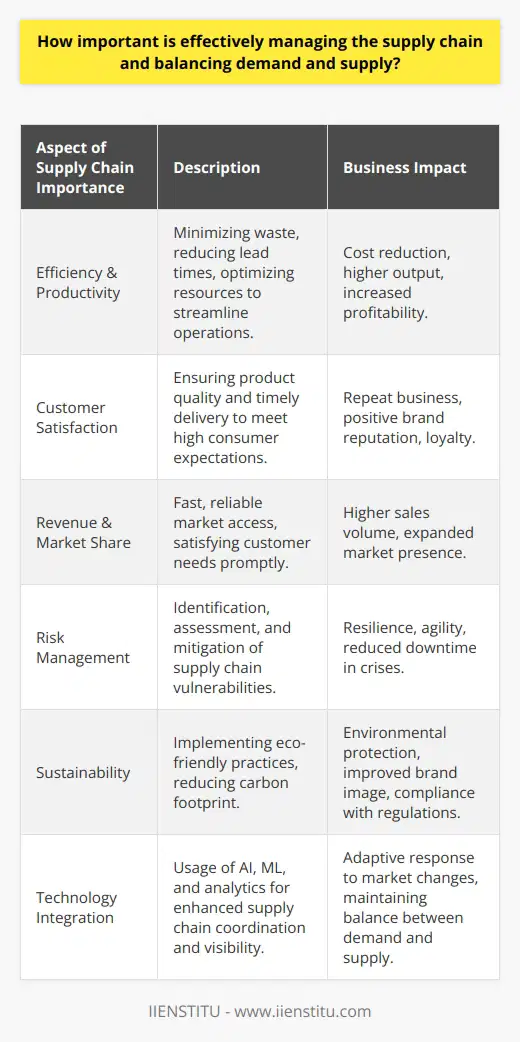
How do you balance supply and demand in supply chain?
Balancing Mechanisms
Balancing supply and demand in a supply chain requires strategic planning and efficient protocols. Fundamental to achieving this harmony is accurate demand forecasting.
Demand Forecasting
Implementing effective forecast systems and methodologies aids in predicting the future demand for products or services. These predictions serve as the basis for procurement, production, and inventory decisions.
Supply Chain Flexibility
Flexibility in the supply chain can help cope with demand fluctuations. Options for increased flexibility include volume flexibility where a business can adjust production volume, and mix flexibility where a change in the production mix is possible according to customer taste or market trends.
Inventory Management
Effective inventory management is key. Stock buffering, for instance, can protect against unforeseen demand. Contrarily, maintaining excessive stock levels can lead to high holding costs.
Lead Time Reduction
Reducing the lead time is another effective strategy. Shorter lead times ensure that production adjustments align swiftly with changes in demand, thus minimizing inventory and stockouts.
Supply and Demand Alignment
Careful alignment of supply with demand ensures the smooth operation of the supply chain. On one hand, businesses should not overproduce, as it can lead to increased storage costs and waste. On the other hand, underproduction may result in lost sales and unsatisfied customers.
Continuous Review
Companies should periodically review their demand forecasts and adjust their supply strategies accordingly. This iterative process enhances accuracy in balancing supply and demand.
In conclusion, achieving supply and demand balance in a supply chain isn't a one-time task. It demands continuous monitoring and adjustment of various components, including demand forecasting, flexibility, inventory management, and lead time.



